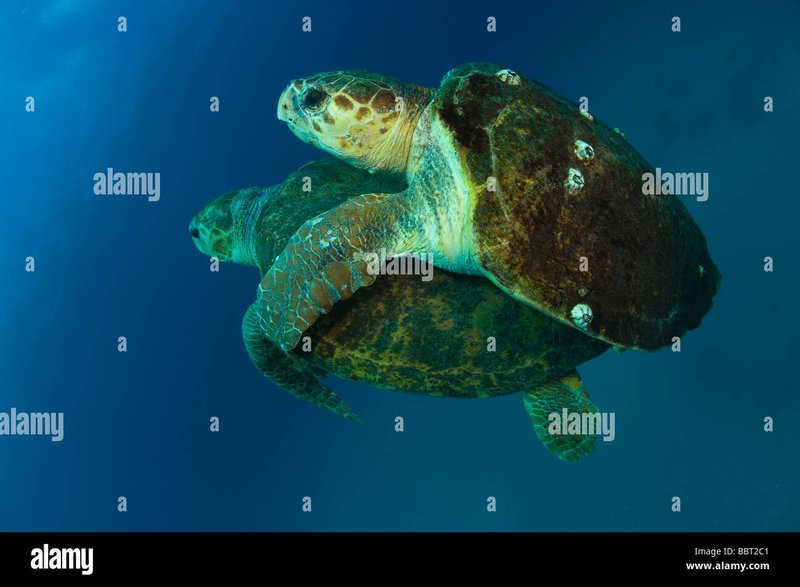
The loggerhead turtle, with its large head and powerful jaws, is quite remarkable in its life cycle. They spend most of their time in the vast ocean, but when it comes time to mate and lay eggs, they return to the same beaches where they first hatched. This incredible instinct poses many questions: How do they find their way? Why do they choose certain beaches? Let’s explore the journey of loggerhead turtles and how they bring new life into the world.
Loggerhead Turtle Life Cycle
Understanding the breeding and reproduction of the loggerhead turtle starts with its life cycle. These turtles begin their journey as tiny eggs laid in nests on sandy beaches. A female loggerhead usually lays 100 to 126 eggs per nest, and she can nest multiple times during a breeding season, which typically spans from late spring to early fall. After about 60 days, the eggs hatch, and the hatchlings scurry towards the ocean, starting their life in the big blue.
Here’s a fun fact: Loggerhead hatchlings are known for their “frenzy,” where they dash into the sea. This instinctual behavior is crucial for survival as they must avoid predators lurking in the shallows. This makes the early stages of a loggerhead’s life quite perilous. Once in the ocean, they enter a phase called the “pelagic stage,” where they drift with ocean currents, feeding on jellyfish and plankton.
Now, you might be wondering, how do these turtles grow up into adults? Generally, loggerheads take about 15 to 30 years to reach sexual maturity. They can live for several decades, with some even reaching over 50 years! This long lifespan allows them plenty of time to find a mate and contribute to the survival of their species.
Mating Rituals of Loggerhead Turtles
When loggerhead turtles are ready to mate, they engage in some fascinating behaviors. During the breeding season, males and females gather at feeding grounds, often in deeper waters. Males are known for their tenacity, often following females and displaying intricate courtship behaviors. These can include gentle nudging and swimming in circles around the female. It’s a bit like a dance, where the male is trying to impress the female with his moves.
Interestingly, loggerhead turtles are not monogamous. Females can mate with multiple males during a single season. This behavior increases genetic diversity in the hatchlings, which is essential for the health of the population. After mating, the female will come ashore to lay her eggs, returning to her nesting beach of choice.
It’s worth noting that loggerheads have a remarkable ability to navigate back to their nesting sites, often returning to the exact spot where they hatched. Scientists believe this may be due to their ability to sense the Earth’s magnetic fields. Isn’t that mind-blowing?
Nesting Habits and Egg Laying
Once a female loggerhead turtle arrives on the beach, she meticulously selects a nesting location. She prefers areas with soft, dry sand and minimal human activity. After digging a hole using her hind flippers, she lays her eggs, covers them, and heads back to the ocean. The nesting process is quite labor-intensive, often taking around 30 minutes to an hour.
After laying her eggs, the female will leave them behind, returning to the ocean to continue her life. The eggs will remain buried under the sand, where they are kept warm by the sun. It’s fascinating to think that the temperature of the sand can determine the sex of the hatchlings: warmer temperatures produce females, while cooler temperatures produce males. This temperature-dependent sex determination is a unique aspect of loggerhead reproduction that researchers find intriguing.
Sadly, many eggs do not make it to hatching due to predators like crabs and birds. It’s an essential reminder of the challenges these turtles face right from the start of their lives.
The Hatchling Journey
The moment the eggs hatch, the tiny loggerhead turtles face their first significant challenge. Emerging from the sand, they must navigate the journey to the ocean, often through a gauntlet of predators and obstacles. This hatchling sprint to the water is crucial. It’s their first test of survival, and those who make it to the ocean quickly are more likely to thrive.
Once they reach the ocean, the hatchlings enter a phase known as the “oceanic stage.” Here, they find themselves in open waters for the next several years, growing and developing. During this time, they rely on ocean currents and their instincts to find food and avoid danger. Honestly, it’s a tough start, but those who survive will grow into the magnificent loggerhead turtles we see in the ocean today.
It’s essential to note that human activities, such as pollution and coastal development, can significantly impact hatchling survival rates. Beach cleanups and protecting nesting areas are critical to ensuring that more hatchlings make it to the safety of the ocean.
Conservation and Protection Efforts
Loggerhead turtles face numerous threats, making conservation efforts vital for their survival. They’re classified as a “threatened” species, primarily due to habitat loss, pollution, and fishing activities. To combat these issues, various organizations and governments have implemented measures to protect nesting sites and reduce bycatch in fishing gear.
One of the most effective methods of protecting these turtles is creating marine protected areas where they can nest without disturbance. Public awareness campaigns also play a crucial role, educating people about the importance of protecting loggerhead turtles and their habitats. Local communities are encouraged to participate in conservation activities, like beach cleanups or monitoring nesting sites.
Here’s the thing: every little effort counts. Simple actions, like adhering to regulations during nesting season or supporting local conservation programs, contribute to the survival of loggerhead turtles. If we all pitch in, we can help ensure that future generations witness these incredible creatures.
The breeding and reproduction of loggerhead turtles is a striking example of the wonders of nature. From their remarkable nesting behaviors to the perilous journey of hatchlings, these turtles showcase resilience and instinct. As they navigate through their complex life cycle, they remind us of the importance of protecting our oceans and the creatures that inhabit them.
By supporting conservation efforts and raising awareness about the challenges loggerhead turtles face, we can make a difference. Together, we can help ensure that these magnificent turtles continue their journey for generations to come. So, next time you think about loggerhead turtles, remember their incredible story and the vital role we play in their survival.

